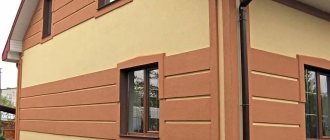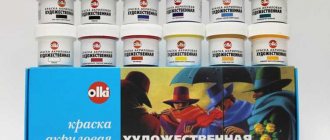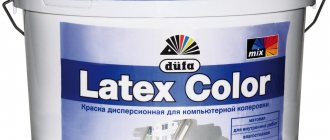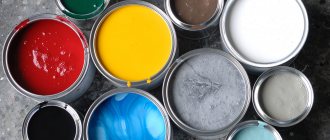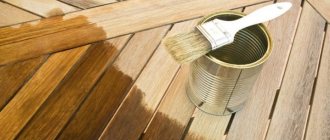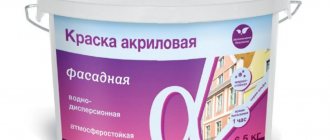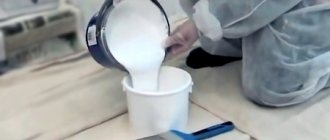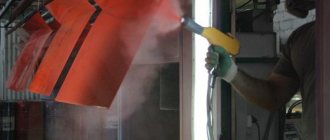Currently, the market for paints and varnishes offers consumers a huge range of products. Among the variety of products in this category, silicone enamels and paints stand out. Due to their high quality characteristics and wide range of colors, these products are popular in construction, renovation, and interior decoration.
Various industrial devices are coated with organopotassium paints for protective purposes.
What is silicone paint
Not everyone knows what organosilicon material is. This product comes in a wide variety of resin, liquid, rubber. The composition contains specific substances, thanks to which a strong and stable connection is formed.
Organosilicon paint is a type of coloring material based on polyorganosiloxane polymers.
The multicomponent suspension contains a large number of coloring pigments. If necessary, organosilicon enamels may include modifying resins and organic solvents.
Briefly about high temperature paint
In addition to painting the surface, silicone enamel can protect it from negative environmental factors. Therefore, in addition to the construction sector, it can be used in other areas of human activity.
Features of the composition
Organosilicon enamel is a product obtained synthetically using air oxygen and silicon. Thanks to the peculiarities of the composition, the reliability and durability of the surface is ensured. This paint and varnish product also contains impurities that can prevent the formation of corrosion, as well as improve the quality and durability of the painted surface.
Acrylic resins and cellulose ether are added to the paint, so it dries quite quickly. The carbide layer ensures the hardness of the painted layer and prevents surface deformation.
The color range of products is expanded due to the inclusion of special pigments. The latter are characterized by the ability to withstand high temperatures without losing their brightness.
Properties of silicone enamels and paints
Silicone paints and varnishes are often used for exterior finishing of buildings. This product has the properties needed for painting outdoor surfaces. The main properties of paints and varnishes are resistance to adverse weather conditions and aggressive environments, as well as durability and water resistance.
There are few disadvantages to such compositions:
- release of toxic fumes;
- causing harm to human health;
- use only for outdoor work;
- impossibility of application on wet surfaces.
Advantages of silicone enamels:
- the ability to paint at a wide range of temperatures (from +40 to -20);
- thermal resistance;
- resistance to combustion and ultraviolet radiation;
- high drying speed;
- low material consumption;
- anti-corrosion resistance;
- affordable price.
Application and composition of silicone enamel for facades
Silicone enamel (not silicone) is used only for external work, as it contains some toxic substances. Before starting work with such paint, craftsmen must be familiar with the safety rules for working with silicone enamel. Technical personnel are simply obliged to ensure that paint is handled correctly. This is very important, since the paint can damage the mucous membranes of the respiratory tract.
Color range of facade paints.
The main difference between this paint and silicone and other paint materials is the fact that it does not contain carbon compounds, but alternating attachments of silicon and oxygen atoms. It is known that such a compound is very strong in a chemical reaction. It is worth noting such a property of silicone enamel as heat resistance, due to which all its physical, mechanical and decorative protective properties are preserved.
Consequently, during the construction or repair work of most industrial facilities, these organosilicon paint materials are mainly used, which are capable of maintaining their operational parameters at different temperatures for a long period. The price in this case is not a hindrance.
Organosilicon paint for building facades.
Enamel based on silicon and oxygen is created synthetically. It has a large margin of safety. Manufacturers introduce specialized targeted additives into its structure, which can achieve excellent anti-corrosion results. Paint manufacturers add ethylcellulose and acrylic resins. Thanks to this composition, it dries quickly at normal temperatures in the open air.
The addition of carbide layers is necessary to increase the hardness of the coating and at the same time increase the resistance to possible mechanical damage. The price of the coating depends on these properties. Specialized hardeners reduce sensitivity to sudden temperature changes. Epoxy resins are needed for silicone paint so that it can easily withstand exposure to aggressive chemicals.
Paints created on the basis of organosilicon additives , which have significantly improved the properties of already commercially available analogues and provided paint and varnish materials with a large number of achieved advantages, enjoy great deserved popularity among consumers
Organosilicon paints have acquired the ability to protect the painted surfaces of materials from various external influences and endowed them with additional useful properties.
Varieties
On the paint and varnish market you can find 2 types of silicone paint. When choosing a particular variety, the consumer must be guided by the conditions of use, the climate of the area, as well as his own preferences.
Limited heat resistant
This type of paint and varnish materials has found its application during facade finishing.
Some enamel pigments are not able to withstand high temperatures, so they are of limited heat resistance. When the temperature rises to + 150 degrees and above, the color pigment is destroyed and the surface fades.
As practice shows, such a coating can withstand adverse environmental conditions. The service life of the paint is about 15 years. They also have good quality characteristics and can be applied at low temperatures.
Heat resistant
In order to prevent corrosion on steel, titanium, aluminum surfaces, as well as to protect the structure from prolonged exposure to high temperatures. In addition, heat-resistant enamel is simply irreplaceable for painting a stove, chimney, or fireplace in order to prevent a decrease in the strength of the attribute. Such materials can withstand temperatures up to 600 degrees above zero. Heat-resistant enamel is available in gray, white, silver, and brown colors.
GOST 11066-74
Official publication
IPC PUBLISHING HOUSE OF STANDARDS Moscow
UDC 677.633.26'621.633:678.84+666.29:678.84:006.354 Group L93
STATE STANDARD OF THE USSR UNION
ORGANIC SILICON HEAT-RESISTANT VARNISHES AND ENAMELS
Specifications
GOST
11066-74
Thermostable silicoorganic lacquers and enamel.
Specifications
OKU 23 1133; 23 1272_
Date of introduction 01/01/75
This standard applies to silicone heat-resistant varnishes and enamels.
Mandatory requirements for varnishes and enamels, aimed at ensuring their safety for life, health and property of the population and environmental protection, are set out in clause 2.1 of table. 1 indicator 2 etc. 5.1, 5.2.
(Changed edition, Amendment No. 4).
BRANDS
1.1. Depending on the composition and purpose, varnishes are produced in the following brands: KO-815; KO-85.
KO-815 is a mixture of solutions of polyphenylsiloxane resin and glyphthalic varnish in toluene or xylene.
KO-85 is a mixture of a solution of polyphenylsiloxane resin in toluene and a solution of polybutyl methacrylate resin in a mixture of acetone, ethyl acetate and butyl acetate.
Varnishes of the KO-815 and KO-85 brands are intended for the production of heat-resistant enamels of the KO-813 and KO-814 brands, obtained by mixing varnishes with aluminum powder PAP-2 (GOST 5494).
Enamels are intended for painting metal products that work for a long time at temperatures up to 500 °C for KO-813 brand enamel and up to 400 °C for KO-814 brand enamel.
Official publication Reproduction prohibited
* © Standards Publishing House, 1974
© IPK Publishing House of Standards, 1997 Reissue with Changes
2. TECHNICAL REQUIREMENTS
2.1. In terms of physical and chemical parameters, organosilicon varnishes of the KO-815 and KO-85 brands must comply with the requirements and standards specified in Table. 1.
Table 1
| Name indicator | Standard for the brand | Test method | |
| KO-815 OKP 23 1133 1500 | KO-85 OKP 23 1133 0900 | ||
| 1. Appearance | Clear liquid from | According to GOST 20841.1 | |
| light yellow to brown | |||
| new color without vision | |||
| of our mechanical | |||
| mesey | |||
| 2. Mass fraction of non- | According to GOST 17537 and according to | ||
| volatile substances,% | clause 4.3 of this standard | ||
| 33-37 | 15-17 | dart | |
| 3. Conditional elm- | According to GOST 8420 | ||
| bone at 20.0±0.5 °C: | |||
| by viscometer VZ-1 | |||
| (nozzle 2.5 mm), with | 12-16 | 20-36 | |
| or | |||
| by viscometer type | |||
| VZ-246 (or VZ-4) with di- | |||
| nozzle diameter 4 mm, with | 10-13 | 12-17 | |
| 4. Acid number, | According to GOST 13526 and | ||
| mg KO N/g varnish, not | clause 4.4 of this standard | ||
| more | 10 | 3 | dart |
| 5. Drying time | According to GOST 19007 and | ||
| films to degree 3, h, | clause 4.2 of this standard | ||
| no more: | dart | ||
| at (20±5) °С | — | 3 | |
| at (150±2) °C | 1 | — | |
| (Changed edition, Rev. No. | 1, 2, 3). |
2.2. KO-813 brand enamel for testing is prepared by mixing 94 parts of KO-815 brand varnish and 6 parts of aluminum powder, and KO-814 brand enamel is prepared by mixing 100 parts of KO-85 brand varnish and 5 parts of aluminum powder and is used within 8 hours after preparation .
2.3. In terms of physical and chemical parameters, enamel grades KO-813, KO-814 must comply with the requirements and standards specified in Table. 2.
table 2
| Name indicator | Standard for the brand | ||
| KO-813 OKP 23 1272 1200 | KO-814 OKP 23 1272 1300 | Test method | |
| 1. Appearance of the film | After drying, the enamel should form a smooth, uniform film of silver color | According to clause 4.5 | |
| 2. Conditional viscosity at (20.0+0.5) °C, s: | According to GOST 8420 | ||
| using a VZ-1 viscometer with a nozzle diameter of 2.5 mm or | 12-17 | 20-40 | |
| by viscometer type VZ-246 (VZ-4) with a nozzle diameter of 4 mm, with | 10-14 | 12-18 | |
| 3. Drying time of the film to degree 3, hours, not more: at (20±5) °С at (150±5) °С | 2 | 2 | According to GOST 19007 and clause 4.6 of this standard |
| 4. Elasticity of the film when bending, mm, no more | 3 | According to GOST 6806 | |
| 5. Film strength upon impact on the U-1 device, cm, not less: at (20±2) °C | 35 | According to GOST 4765 and clause 4.7 of this standard | |
| after heat treatment for 3 hours: at 330-350 VС at 450-500 VС | 15 | 50 |
Continuation of the table. 2
| Name indicator | Standard for the brand | ||
| KO-813 OKP 23 1272 1200 | KO-814 OKP 23 1272 1300 | Test method | |
| 6. Resistance of the film to the static effects of water at (20±5) °C, h, not less | 24 | 24 | According to GOST 9.403 and clause 4.8 of this standard |
| 7. Resistance of the film to the static effects of gasoline at (20±5) °C, h, not less | 24 | 24 | According to GOST 9.403 and clause 4.9 of this standard |
(Changed edition, Amendment No. 3).
3. ACCEPTANCE RULES
3.1. Acceptance rules - according to GOST 9980.1.
(Changed edition, Amendment No. 3).
3.2. Norms for indicators 6 and 7 of table. 2 the manufacturer determines periodically, at least once a quarter.
3.3. If unsatisfactory results of periodic tests are obtained, the manufacturer checks each batch until satisfactory test results are obtained in a row of at least three batches.
3.2, 3.3. (Introduced additionally, Amendment No. 4).
3.4. (Deleted, Amendment No. 2).
4. TEST METHODS
4.1. Sampling - according to GOST 9980.2.
The weight of the average sample must be at least 1 kg.
4.2. Preparation of samples for testing.
4.2.1. The appearance, drying time to degree 3 and the elasticity of the film when bending are determined on black tin plates with a thickness of 0.25-0.32 mm and a size of 30 x 100 mm. The strength of films upon impact and the resistance of the film to the static effects of gasoline are determined on plates made of steel grades 10, Yukp, 20, 20kp according to GOST 1050, or steel grade 08kp according to GOST 9045, or steel grades
08kp and 08ps according to GOST 16523 with a thickness of 0.8-1.0 mm and dimensions of 70 x 150 mm. To determine the resistance of the film to the static effects of water, plates of duralumin grade D 16 according to GOST 21631, 1 mm thick and 30 x 120 mm in size, are used.
4.2.2. Plates for applying varnishes and enamels are prepared in accordance with GOST 8832, section. 3.
Steel plates are blown with technical shot No. 03, 05 according to GOST 11964 from cast iron and steel or with quartz sand grades S-070-1 or S-070-2 according to GOST 22551 in a sandblasting chamber installation, or with metal sand, or electrocorundum and washed with nefras according to NTD and GOST 3134, or toluene according to GOST 9880 or GOST 14710.
4.2.3. Before application to the substrate, varnishes are kept at (20±5) °C until the release of air bubbles stops. To determine the drying time, the varnish is applied by double dipping according to GOST 13526. The thickness of the dry film is not taken into account. After applying the first layer, the sample is kept at (20±5) °C for 15-20 minutes, then the second layer is applied and dried in accordance with paragraph 5 of the table. 1.
After hot drying, the sample is cooled to a temperature of (20±5) °C and tested.
4.2.1—4.2.3. (Changed edition, Amendment No. 3).
4.2.4. Before testing, KO-814 enamel is diluted with solvent R-5 to a viscosity of 12-14 s using a VZ-1 viscometer (2.5 mm nozzle) or to a viscosity of 10-11 s using a VZ-246 (and VZ-4) viscometer according to GOST 9070 and filtered through a double layer of gauze.
Enamels are applied with a paint sprayer in one layer according to GOST 8832 in an amount of 20-28 g/m2 for enamel of the KO-813 brand and 15-20 g/m2 for enamel of the KO-814 brand (counting on a dry film).
To determine the appearance of the film, the elasticity of the film when bending, the strength of the film upon impact, the resistance of the film to water and gasoline, KO-813 enamel is applied to plates, kept at ambient temperature for 1-2 hours and then dried at (150± 2) °C for 2 hours, cooled to a temperature of (20±5) °C, and tests are carried out without additional exposure, and KO-814 enamel after drying at (20±5) °C for 2 hours is kept at that same temperature for another 24 hours.
When determining the resistance of films to water and gasoline, enamel is applied to both sides of the plates.
(Changed edition, Amendment No. 2, 3).
4.3. The mass fraction of non-volatile substances in varnishes is determined according to GOST 17537. The exposure time of the sample in a thermostat at (100 ± 2) °C is 3 hours.
4.4. Determination of the acid number of varnishes is carried out according to GOST 13526.
When determining the acid number of varnish brand KO-815, a 3-5 g sample of varnish is dissolved in pre-neutralized ethyl alcohol according to GOST 18300 and titrated with an alcoholic solution of potassium hydroxide with a concentration of 0.1 mol/dm3 (0.1 N).
4.3, 4.4. (Changed edition, Amendment No. 3).
4.5. The appearance of the enamel film is determined visually in natural diffused light.
4.6. Drying time to degree 3 of enamels films is determined according to GOST 19007 on samples prepared according to clause 4.2 and dried in accordance with subclause 3 of table. 2.
Drying time for samples is 15-20 minutes at (20±5) °C.
After hot drying, the samples are cooled to a temperature of (20±5) 'C and tested.
(Changed edition, Amendment No. 3).
4.7. The strength of the enamel film upon impact after heat treatment is determined according to GOST 4765.
The samples prepared according to clause 4.2 are placed in a muffle furnace and kept in it for 3 hours for KO-813 enamel at 450-500 °C and for KO-814 enamel at 330-350 °C. Then the plates are removed from the muffle furnace and cooled to (20±2) °C, after which the strength of the films upon impact is determined.
4.8. The resistance of the film to the static effects of water is determined according to GOST 9.403, method A. Samples after testing in water for the time specified in clause 6 of table. 2, keep in air at (20±5) °C for 2 hours and inspect the appearance of the film. The enamel film should remain unchanged.
4.9. The resistance of the film to gasoline is determined according to GOST 9.403. The samples are kept in gasoline according to GOST 1012 for the time specified in paragraph 7 of the table. 2. When removed from gasoline, the enamel film should not have any swelling. After exposure to air at (20±5) °C for 1 hour, the enamel film should not be destroyed when brushed over it with a bristle brush 14-18.
4.8, 4.9. (Changed edition, Amendment No. 1, 3).
5. PACKAGING, LABELING, TRANSPORTATION
AND STORAGE
5.1. Packaging - according to GOST 9980.3.
It is allowed to pack varnishes in aluminum cans belonging to the manufacturer and steel barrels in accordance with GOST 6247 and GOST 13950 with a capacity of 200 dm3. By agreement with the consumer, it is allowed to pack varnishes in containers with a capacity of no more than 50 dm3. Cans are packaged in a lattice box in accordance with GOST 2991, type U-1, or in wooden boxes made according to specifications and technical documentation for one can.
5.2. Marking - according to GOST 9980.4.
The transport container must be marked with a danger sign (Fig. 3), hazard class 3, classification code 3212 in accordance with GOST 19433. UN serial number 1263.
5.3. Transportation and storage - in accordance with GOST 9980.5.
Sec. 5. (Changed edition, Amendment No. 4)
MANUFACTURER'S WARRANTY
6.1. The manufacturer guarantees that varnishes comply with the requirements of this standard subject to storage and transportation conditions.
(Changed edition, Amendment No. 2, 3).
6.2. The guaranteed shelf life of varnishes is three years from the date of manufacture.
(Changed edition, Amendment No. 3).
Scope of application
Organosilicon compounds have found their application in many areas of human activity. Construction and industry cannot do without these products.
In construction
In the field of construction and repair of structures, enamels are used for decorative atmospheric painting of surfaces on the outside of buildings. With the help of such enamel you can protect brick, concrete, stone, plastered, wooden and metal structures. Due to their hydrophobic properties, these materials are used in the process of protective painting of building foundations and slates.
In industry
Various industrial devices are coated with organopotassium paints for protective purposes. For example, electric motors, transformers, internal combustion engines. They cannot do without paint and varnish compositions of this type during the construction of bridges, ships, and ports. In the national economy, industry also uses this enamel, especially where mechanisms, tanks and other devices operate under high temperature conditions.
Advantages and disadvantages
Paints and varnishes related to the organosilicon type, except for those inherent in them
properties also have their own distinctive features, advantages and disadvantages relative to other types of paints and enamels that are used for painting surfaces.
The main advantages of existing silicone paints are the advantages achieved during their production:
- heat resistance;
- moisture resistance and water resistance;
- fire resistance;
- light fastness, resistance to ultraviolet rays;
- atmospheric stability;
- chemical resistance;
- quick drying of the painted surface;
- frost resistance;
- wide range of colors;
- low consumption of materials when painting;
- the possibility of painting the surface at negative temperatures reaching -20 degrees;
- providing effective anti-corrosion protection to metal products.
Among the disadvantages of industrially produced silicone paints, the following should be noted:
- toxicity of fumes that are released during the drying process of the material;
- negative effects on the human body due to prolonged contact with enamels;
- use of paints and varnishes of this type exclusively for exterior work.
Organosilicon paint and varnish compositions differ from most similar types of paints in their low price, as well as in the process of adding additives to the materials, a number of very important parameters that are used in many industries and the national economy.
Unlike other types of paint, organosilicon paint and varnish material does not require priming of the surface to be painted, and the chromium compounds introduced into the composition make the enamels very resistant to mechanical stress. Similar types of paints do not have such capabilities and characteristics.
Paint application technology
Application of paints and varnishes must be careful and consistent. The master should not forget about preparing the equipment necessary for the work, as well as purchasing a sufficient amount of enamel for a specific surface area.
Preparing the base
Before painting, each surface needs careful preparation:
- Initially, the plastered facade is cleaned of dust, dirt, and all kinds of stains. For work, you can use a construction vacuum cleaner. You can get rid of pieces of old coating using an iron spatula.
- The clean surface is plastered or puttied, since it will be almost impossible to hide all sorts of defects with paint.
- Apply a layer of primer with a roller. It should be uniform and neat.
Painting
Application of organopotassium paint or enamel can be carried out in the following ways:
- With a paint roller or brush. However, with such painting it is difficult to control the coating layer, which plays an important role in the quality of adhesiveness.
- Pneumatic spray gun. Despite the simplicity and speed of the work, this method has some disadvantages: high consumption of enamel and the release of toxic substances into the environment.
- Immersion of parts in enamel. This method is only suitable if the dimensions of the attributes match the volume of the paint container.
Application Tips
To ensure that the organopotassium paint coating lasts as long as possible and does not change its color, experts recommend applying it in a layer of up to 50 microns. To prevent the indicator from being exaggerated, it is worth painting the facade 2 or 3 times with a break of 15 minutes.
Some metal surfaces are best cleaned before painting. Degrease and coat with primer.
It is recommended to clean old cracked coating using mechanical or chemical methods. When using organopotassium enamels, you must strictly adhere to safety precautions, thereby protecting yourself from toxic fumes.
